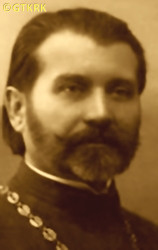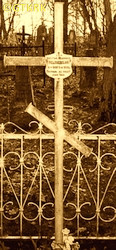Roman Catholic
St Sigismund parish
05-507 Słomczyn
85 Wiślana Str.
Konstancin deanery
Warsaw archdiocese, Poland
full list:
displayClick to display full list

searchClick to search full list by categories
wyświetlKliknij by wyświetlić pełną listę po polsku

szukajKliknij by przeszukać listę wg kategorii po polsku

Martyrology of the clergy — Poland
XX century (1914 – 1989)
personal data
surname
NIEDŹWIEDZKI
forename(s)
Nicholas (pl. Mikołaj)
function
presbiter (i.e. iereus)
creed
Eastern Orthodox Church ORmore on
en.wikipedia.org
[access: 2014.09.21]
diocese / province
Vilnius‐Lida OR eparchy (Polish Autocephalous Orthodox Church PAOC)more on
pl.wikipedia.org
[access: 2023.04.02]
date and place
of death
09.1939

Senezhitsytoday: Brolniki ssov., Navahrudak dist., Grodno reg., Belarus
more on
be.wikipedia.org
[access: 2024.01.26]
details of death
After the German attack on Poland on 01.09.1939 (the Russians attacked 17 days later) and the start of World War II, after the beginning of the Russian occupation in the village where he ministered on 18.09.1939 — due to the complete collapse of Polish power and the fact that the Russians did not yet take over power — Belarus experienced a period of anarchy.
At the same time, special communist sabotage groups, trained and armed with machine guns and grenades by the Russians, joined the action. Composed mainly of communized Jews, Belarusians — and in Ukraine also Ukrainians — were supposed to enable the Russians to quickly take over Polish territory. This state of anarchy lasted from c. 17.09.1939 to the end of 09.1939.
One night, several armed men, local communist activists, broke into his house, opposite the church in Volkovichi. Dragged him out of the house.
Chased him through the village, beating with an iron rods, and pulling his beard and mustache.
Was taken first through the small village of Gorevichi to the village of Omnevichi (c. 2.5 km from Volkovichi), where was forced to move on all fours, with bandits sitting on his back.
There, on a nearby farm, was locked in a barn for two days.
On the third day, was driven to the forest near the village of Senezhitsy, up a small wooded hill, where was murdered.
First was forced to dig a hole, had ears cut off, eyes gouged out, bones broken, tongue torn out and genitals cut off. Then his legs were tied, a rope was thrown over a branch and his body was lowered into the grave.
Today, the faithful call the crime scene „Navahrudak Golgotha”.
cause of death
murder
perpetrators
Belarusians
sites and events
Ribbentrop‐MolotovClick to display the description
date and place
of birth
08.05.1890

Nowa Wolatoday: Michałowo gm., Białystok pov., Podlaskie voiv., Poland
more on
en.wikipedia.org
[access: 2024.01.26]
positions held
c. 02.05.1938
protoiereus (Eng. first priest) — Polish Autocephalous Orthodox Church PACP — dignity conferment
09.12.1927 – 1939
parish priest — Volkovichitoday: Brolniki ssov., Navahrudak dist., Grodno reg., Belarus
more on
be.wikipedia.org
[access: 2024.01.26] ⋄ Dormition of the Blessed Virgin Mary OR parish ⋄ Navahrudaktoday: Navahrudak dist., Grodno reg., Belarus
more on
en.wikipedia.org
[access: 2021.07.04] OR deanery — appointment: on 19.11.1927
03.10.1927
parish priest — Mizhevichitoday: Mizhevichi ssov., Slonim dist., Grodno reg., Belarus
more on
be.wikipedia.org
[access: 2024.01.26] ⋄ Nativity of the Blessed Virgin Mary OR parish
20.03.1927
deputy dean — Dzyatlavatoday: Dzyatlava dist., Grodno reg., Belarus
more on
en.wikipedia.org
[access: 2022.01.06] OR deanery — acting („ad interim”)
23.09.1925
parish priest — Nogorodovichitoday: Zhukovshchina ssov., Dzyatlava dist., Grodno reg., Belarus
more on
be.wikipedia.org
[access: 2023.07.16] ⋄ St Nicholas the Wonderworker OR parish ⋄ Dzyatlavatoday: Dzyatlava dist., Grodno reg., Belarus
more on
en.wikipedia.org
[access: 2022.01.06] OR deanery
priest — Melkanovichitoday: Kosteni ssov., Slonim dist., Grodno reg., Belarus
more on
be.wikipedia.org
[access: 2024.01.26] ⋄ Dormition of the Blessed Virgin Mary OR parish
20.08.1921
parish priest — Nogorodovichitoday: Zhukovshchina ssov., Dzyatlava dist., Grodno reg., Belarus
more on
be.wikipedia.org
[access: 2023.07.16] ⋄ St Nicholas the Wonderworker OR parish ⋄ Dzyatlavatoday: Dzyatlava dist., Grodno reg., Belarus
more on
en.wikipedia.org
[access: 2022.01.06] OR deanery — acting („ad interim”)
till 1921
teacher — Nowa Wolatoday: Michałowo gm., Białystok pov., Podlaskie voiv., Poland
more on
en.wikipedia.org
[access: 2024.01.26] ⋄ private Orthodox school ⋄ Nativity of St John the Baptist OR parish
student — Vilniustoday: Vilnius city dist., Vilnius Cou., Lithuania
more on
en.wikipedia.org
[access: 2022.01.06] ⋄ philosophy and theology, Orthodox Theological Seminary
married — one foster daughter
comments
None of the criminals were punished. Even during the short period of 1941‐1942, after the beginning of the German occupation as a result of the German attack on 22.06.1941 on their erstwhile ally, the Russians, when in several cases the Germans filed lawsuits against the most zealous Russian collaborators, no one in Volkovichi and its vicinity wanted to point out the perpetrators. Just like in 1939, then and for many decades to come, doors and shutters were closed, and the events were observed only from behind the cracks and curtains. Fear, combined with shame, is the best weapon of tyrants. However, fate did not treat the murderers kindly: two hanged themselves, one drowned in a pond, another fell under the wheels of a horse–drawn cart while drunk, and another disappeared in Siberia…
others related
in death
BOROWSKIClick to display biography Michael, BUKOClick to display biography Eugraphius, JAKUBSONClick to display biography David, KUCClick to display biography Andrew, KAMIŃSKIClick to display biography Simon
sites and events
descriptions
Ribbentrop‐Molotov: Genocidal Russian‐German alliance pact between Russian leader Joseph Stalin and German leader Adolf Hitler signed on 23.08.1939 in Moscow by respective foreign ministers, Mr. Vyacheslav Molotov for Russia and Joachim von Ribbentrop for Germany. The pact sanctioned and was the direct cause of joint Russian and German invasion of Poland and the outbreak of the World War II in 09.1939. In a political sense, the pact was an attempt to restore the status quo ante before 1914, with one exception, namely the „commercial” exchange of the so‐called „Kingdom of Poland”, which in 1914 was part of the Russian Empire, fore Eastern Galicia (today's western Ukraine), in 1914 belonging to the Austro‐Hungarian Empire. Galicia, including Lviv, was to be taken over by the Russians, the „Kingdom of Poland” — under the name of the General Governorate — Germany. The resultant „war was one of the greatest calamities and dramas of humanity in history, for two atheistic and anti‐Christian ideologies — national and international socialism — rejected God and His fifth Decalogue commandment: Thou shall not kill!” (Abp Stanislav Gądecki, 01.09.2019). The decisions taken — backed up by the betrayal of the formal allies of Poland, France and Germany, which on 12.09.1939, at a joint conference in Abbeville, decided not to provide aid to attacked Poland and not to take military action against Germany (a clear breach of treaty obligations with Poland) — were on 28.09.1939 slightly altered and made more precise when a treaty on „German‐Russian boundaries and friendship” was agreed by the same murderous signatories. One of its findings was establishment of spheres of influence in Central and Eastern Europe and in consequence IV partition of Poland. In one of its secret annexes agreed, that: „the Signatories will not tolerate on its respective territories any Polish propaganda that affects the territory of the other Side. On their respective territories they will suppress all such propaganda and inform each other of the measures taken to accomplish it”. The agreements resulted in a series of meeting between two genocidal organization representing both sides — German Gestapo and Russian NKVD when coordination of efforts to exterminate Polish intelligentsia and Polish leading classes (in Germany called «Intelligenzaktion», in Russia took the form of Katyń massacres) where discussed. Resulted in deaths of hundreds of thousands of Polish intelligentsia, including thousands of priests presented here, and tens of millions of ordinary people,. The results of this Russian‐German pact lasted till 1989 and are still in evidence even today. (more on: en.wikipedia.orgClick to attempt to display webpage
[access: 2015.09.30])
sources
personal:
nashaniva.comClick to attempt to display webpage
[access: 2024.01.26], niva.bialystok.plClick to attempt to display webpage
[access: 2024.01.26], niva.bialystok.plClick to attempt to display webpage
[access: 2024.01.26]
bibliographical:
„Hierachy, clergy and employees of the Orthodox Church in the 19th‐21st centuries within the borders of the Second Polish Republic and post–war Poland”, Fr Gregory Sosna, M. Antonine Troc-Sosna, Warsaw–Bielsk Podlaski 2017
original images:
nashaniva.comClick to attempt to display webpage
[access: 2024.01.26], niva.bialystok.plClick to attempt to display webpage
[access: 2024.01.26]
LETTER to CUSTODIAN/ADMINISTRATOR
If you have an Email client on your communicator/computer — such as Mozilla Thunderbird, Windows Mail or Microsoft Outlook, described at WikipediaPatrz:
en.wikipedia.org, among others — try the link below, please:
LETTER to CUSTODIAN/ADMINISTRATORClick and try to call your own Email client
If however you do not run such a client or the above link is not active please send an email to the Custodian/Administrator using your account — in your customary email/correspondence engine — at the following address:

giving the following as the subject:
MARTYROLOGY: NIEDŹWIEDZKI Nicholas
To return to the biography press below:
 Click to return to biography
Click to return to biography









